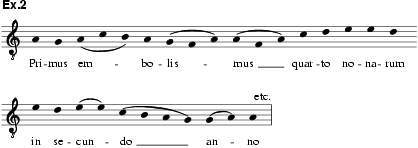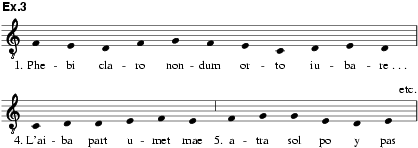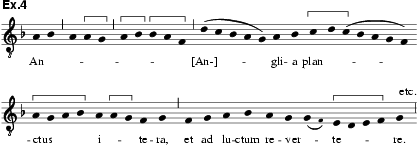
A repertory which, largely because of the nature of poetic transmission in the Middle Ages, comprises much of the earliest surviving European secular song with music. In contrast to the many collections of liturgical chant and Latin sacred songs surviving from the millennium before about 1300, Latin secular songs with music are relatively rare; but secular poems that were probably sung are more plentiful. Of the songs preserved with music, very few notated before the 12th century can be transcribed with any certainty.
2. The Carolingian renaissance.
3. The ‘goliard’ period up to c1300.
GORDON A. ANDERSON/THOMAS B. PAYNE
The 8th and 9th centuries produced many sung Latin poems, not only sacred, but also epics, odes, laments, satires, eulogies, and lyric and didactic verses; yet a predilection for classical studies restricted the use of rhymed rhythmic verse, and might even have stifled it altogether had not a close association with music in the following two centuries given it new vigour. Meanwhile poetico-musical activity continued in the monasteries of southern France and northern Italy, an important outcome of which was the development of refrain forms and the addition of partly diastematic neumes to the texts in the manuscripts. The revival of classical studies resulted in a number of contemporary musical settings of ancient authors. Neumes survive for six Horace odes (i, 1, 3, 33; iii, 9, 13; iv, 11); two extracts from Virgil’s Aeneid(ii, 281ff; iv, 651ff); three extracts from Statius’s Thebais (v, 608ff; xii, 325ff, 336ff); Juvenal’s Satires (viii, 78ff); Trajan’s Ut belli sonuere; Priscian’s Ad Boree partes; Scande celi from Martianus Capella’s De nuptiis Philologiae et Mercurii(ii); and five poems from Boethius’s De consolatione Philosophiae (metrum i, 1, 5; ii, 5; iii, 8; iv, 7). It is possible that these simple settings were used for didactic purposes, or to teach rhetoric or quantitative scansion: one of the two tunes (Horace, Ode, iv, 11) that can reliably be transcribed is set to the version of the hymn tune Ut queant laxis, which was later adapted to didactic use by Guido of Arezzo, and the other (Boethius, metrum iv, 7) occurs in the Dialogus de musica formerly attributed to Odo of Cluny (ex.1).

A didactic purpose lies behind a number of melodies that accompany 10th- to 13th-century computus verses, which link the liberal arts studies of music and astronomy within the doctrine of the music of the spheres. Some of their melodies are in lined notation, and show a recitation style with some melodic emphasis at the cadences. A few are strophic, though generally they are through-composed, and some of them are of great length. The opening of a 12th-century German example (ex.2) illustrates the style.

A last great flowering of Latin secular song follows the period of Carolingian court songs. It issues principally from two interrelated sources: the monasteries of southern France and the so-called Goliards or wandering scholars (the term has often been associated with secular Latin poets of the later Middle Ages, but is probably inaccurate). On the one hand, there occurred unparalleled activity in creating new paraliturgical and sacred musical works – tropes, sequences, conductus and motets; on the other hand, songs of a similar kind, but with secular texts – love-lyrics, spring songs, moral, satirical and drinking-songs – were written and preserved in great numbers, quite often in the same sources that transmit sacred texts. From the extant sources it is possible to trace the development of these forms from the 10th century to their highest point in the 12th century and through their gradual decline during the 13th century. The earlier period established the principle of rhymed, rhythmic and strophic verse meant for singing. During the ensuing development poetic rhyme, verse structure and musical balance coalesced into free forms that suggest increased attention to detail and formal design. Besides sacred music, two further developments strongly influenced secular Latin songs: the vernacular chansons of the troubadours and trouvères, and the great popularity of Marian settings, the texts of which varied from poetic fancy rich in imagery and Old Testament exegesis to the most facile stringing together of Our Lady’s attributes. The music tended to be less learned and of a popular cast. Owing to the close interaction of these various elements it is often very difficult to separate secular from sacred; manuscripts usually mix poems of both types, and the common use of contrafactum texts tends to obscure the distinction even further. Whereas vernacular song tended to become localized, the Latin tradition became truly international, and many songs are found separately transmitted in manuscripts from all over Europe.
A change of poetic-musical emphasis can be observed in several transitional 10th-century works which, though belonging to the older Carolingian tradition, point decisively to a new emphasis on lyricism in the manner of the vernacular repertories. Ex.3 (late 10th century) illustrates this trend and emphasizes the close connection between Latin and vernacular traditions, which in this dawn song with Latin stanza and Provençal refrain also suggests a clerical origin.

Both texts and music of the ‘goliard’ songs display a wide range of expression and musical forms. The poetry is often characterized by verbal charm and simplicity though framed in sophisticated verse forms enhanced by an interplay of rhymes and rhythms, while intricate word play is common. The more scurrilous songs display a penetrating understanding of the social and religious structures of the times, so that a carefree and abandoned attitude, often supremely witty and apposite, attacks by implication all that established tradition held to be sacrosanct, while directing trenchant satire and bitter polemic against official abuses. Charming and graceful lyrics that evoke tender or erotic feelings are also common. Similarly, the melodies range from simple strophic settings to highly complex and melismatic through-composed forms; the latter style is illustrated by the opening of a late 12th-century planctus from the Notre Dame conductus repertory (ex.4).

Many fragmentary sources and several large collections of songs are extant from the final period; taken together they present a remarkable and diverse picture of late Latin secular song. The main features of the repertory may be traced by reference to the songs in the larger collections.The earliest of these is an 11th-century manuscript known as ‘The Cambridge Songs’ (GB-Cu Gg.5.35; for illustration see Sources, MS, §III, 2, fig.20), which contains some pieces from previous centuries (such as O admirabile Veneris ydolum and the ‘Modus Ottinc’ already referred to) and bridges the late Carolingian period and the newer trends of the ‘goliard’ poets. It is significant that many of the pieces are in sequence form, and that this is the first extensive collection of secular texts that are unequivocally connected with musical settings. Also, these and the following secular Latin songs are products of a learned society and, though influenced by folklore and Latin colloquialisms, they would not have been understood by the laity. A most diverse collection of sacred music, proses, tropes and conductus, is contained in the four principal St Martial manuscripts (see St Martial); among them are some 14 wholly secular works, and others that belong to that indeterminate position between sacred and secular. They are mostly strophic in form, and show the influence of vernacular and sequence forms by frequently having a formal repeat of the first phrase or versicle, while many continue with still further repetition. Melismas and melodic ornaments are also commonly used, indicating a movement away from simpler syllabic styles for Latin secular songs, so that beauty of melodic form now gains emphasis. Two further collections of secular songs mixed with sacred, from a slightly later period, continue the tradition there established: the 28 ‘Arundel Songs’ (GB-Lbl Arundel 384; 14th century) lack notation, and only a few of their melodies can be recovered from concordances; in a second Cambridge collection (GB-Cu Ff.i.17; 13th century) of 35 songs, all have staves, but some lack notation. Here we enter the mature period of songs with rhymed rhythmic Latin verse.
The largest and most important collection of ‘goliard’ songs is the Carmina Burana (D-Mbs Clm 4660) probably from southern Germany. Some 46 of its poems are provided with unheighted neumes, and one must look to concordances to decipher the melodies, about 30 of which have been recovered with some certainty. Closely related to this tradition are many Latin Conductus, lyric songs and rondeaux of the Notre Dame sources, and much of the Latin music in the Roman de Fauvel; written in excellent notation, they form the last great repository of medieval moral and secular songs. It would appear that with these collections the centre of activity shifted to Paris, that with the establishment of the university in the early 13th century the ‘goliard’ fraternity was replaced by resident teachers and scholars, and that from this point secular Latin song quickly waned.
W. Meyer: Die Arundel Sammlung mittellateinischer Lieder (Berlin, 1908)
M. Manitius: Geschichte der lateinischen Literatur des Mittelalters (Munich, 1911–31/R)
F. Ludwig: ‘Die geistliche nichtliturgische und weltliche einstimmige und die mehrstimmige Musik des Mittelalters bis zum Anfang des 15. Jahrhunderts’, Handbuch der Musikgeschichte, ed. G. Adler (Frankfurt, 1924, 2/1930/R), 157–295
H. Spanke: ‘St. Martial-Studien’, Zeitschrift für französische Sprache und Literatur, liv (1930–31), 282–317, 385–422; lvi (1932–33), 450–78
F.J.E. Raby: A History of Secular Latin Poetry in the Middle Ages (Oxford, 1934, 2/1957)
H. Spanke: ‘Ein lateinisches Liederbuch des 11. Jahrhunderts’, Studi medievali, new ser., xv (1942), 111–42
O. Schumann: ‘Die jüngere Cambridger Liedersammlung’, Studi medievali, new ser., xvi (1943–50), 48–85
S. Corbin: ‘Comment on chantait les classiques latins au moyen age’, Mélanges d’histoire et d’esthetiques musicales, i (Paris, 1955), 107–13
G. Vecchi: ‘Il “Planctus” di Gudino di Luxeuil: un ambiente scolastico, un ritmo, una melodia’, Quadrivium, i (1956), 19–40
W. Irtenkauf: ‘Der Computus ecclesiasticus in der Einstimmigkeit des Mittelalters’, AMw, xiv (1957), 1–15
E. Jammers: ‘Das mittelalterliche deutsche Epos und die Musik’, Heidelberger Jb, i (1957), 31–90
M. Huglo: ‘A Lament for William the Conqueror’, MT, cviii (1967), 124–5
P. Dronke: Medieval Latin and the Rise of European Love-Lyric (Oxford, 1965–6, 2/1968)
M. Schuler: ‘Die Musik an den Höfen der Karolinger’, AMw, xxvii (1970), 23–40
J. Szövérffy: Weltliche Dichtungen des lateinischen Mittelalters: ein Handbuch (Berlin, 1970)
E. Jammers: Aufzeichnungweisen der einstimmigen ausserliturgischen Musik des Mittelalters (Cologne, 1975)
A.G. Rigg and G.R.Wieland: ‘A Canterbury Classbook of the Mid-Eleventh Century’, Anglo Saxon England, iv (1975), 113–30
P. Dronke: ‘Profane Elements in Twelfth-Century Literature’, Renaissance and Renewal in the Twelfth Century, ed. G. Constable and R.L. Benson (Cambridge, MA, 1982), 569–92
A.G. Rigg: ‘Medieval Latin Poetic Anthologies’, Medieval Studies, xxxix (1977), 281–330; xl (1978), 387–407; xli (1979), 468–505; xliii (1981), 472–97
D. Schaller and E.Könsgen: Initia carminum Latinorum saeculo undecimo antiquorum (Göttingen, 1977)
P. Dronke: ‘The Song of Songs and Medieval Love-Lyric’, The Bible and Medieval Culture, ed. W. Lourdaux and D. Verhelst (Leiden, 1979), 236–62
L. Richter: ‘Die beiden ältesten Liederbucher des latienischen Mittelalters’, Philologus, cxxiii (1979), 63–8
C. Page: ‘The Boethian Metrum Bella bis quinis: a New Song from Saxon Canterbury’, Boethius: his Life, Thought and Influence (Oxford, 1981), 306–11
J. Szövérffy: ‘Cambridge Songs’, Dictionary of the Middle Ages, iii (New York, 1982–9), 57–8
C. Page and others: ‘Neumed Boethian metra from Canterbury: a Newly-Recovered Leaf of Cambridge, Gg 5.35’, Anglo Saxon England, xii (1983), 141–52
P. Dronke: The Medieval Poet and his World (Rome, 1984)
A.G. Rigg: ‘Eraclius Archipoeta: Bekynton Anthology nos. 14, 15, 20, 77’, Medium aevum, liii (1984), 1–9
P. Godman: Poetry of the Carolingian Renaissance (Norman, OK, 1985)
J. Stevens: Words and Music in the Middle Ages: Song, Narrative, Dance, and Drama, 1050–1350 (Cambridge, 1986) [esp. chap.1–4]
B. Gillingham, ed.: Secular Medieval Latin Song, i: An Anthology, ii: A Critical Study (Ottawa, 1993–5)
J.M. Ziolkowski: The Cambridge Songs (Carmina Cantabrigensia) (Hamden, CT, 1994)
For more specific bibliography see Carmina Burana and Goliards.